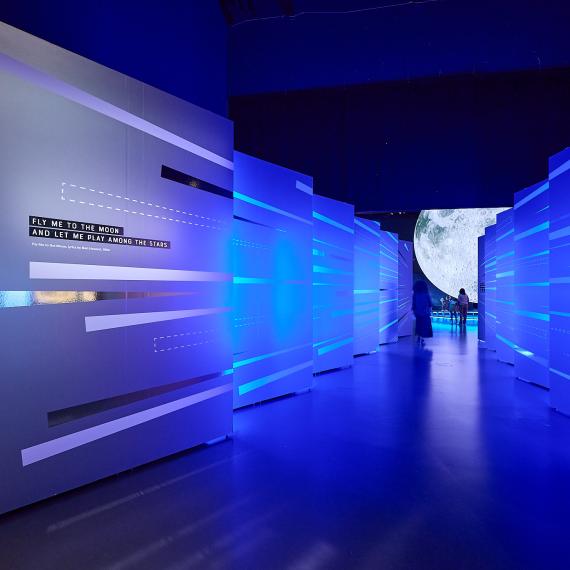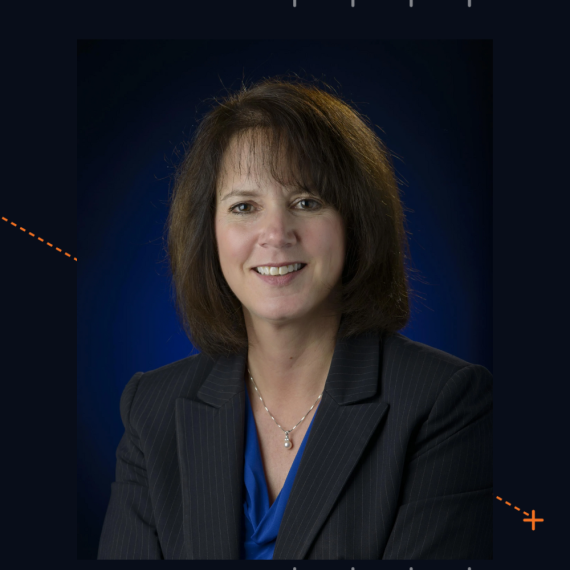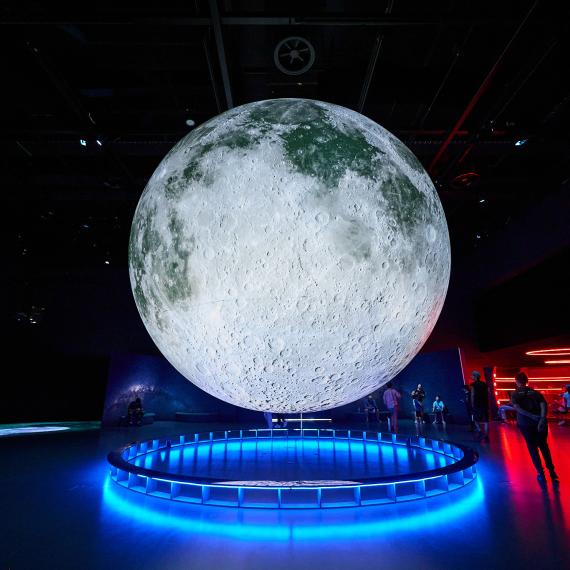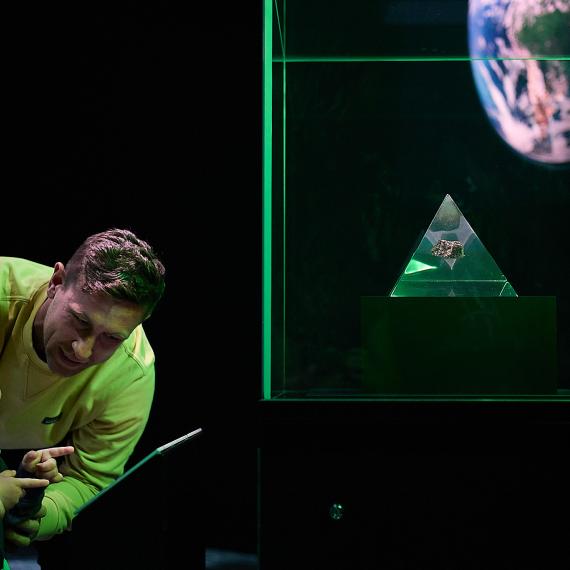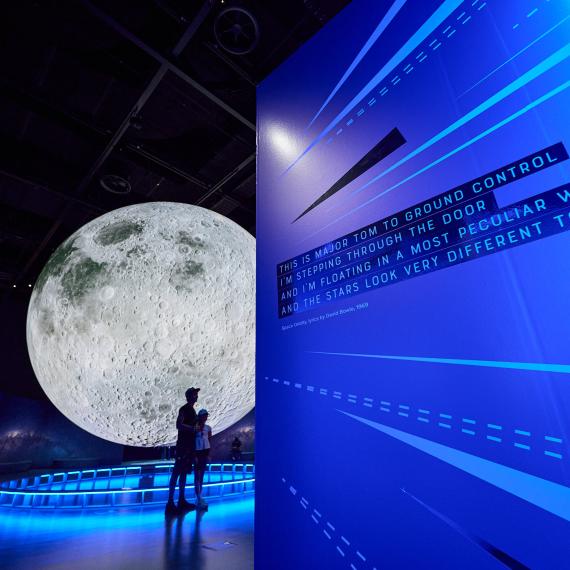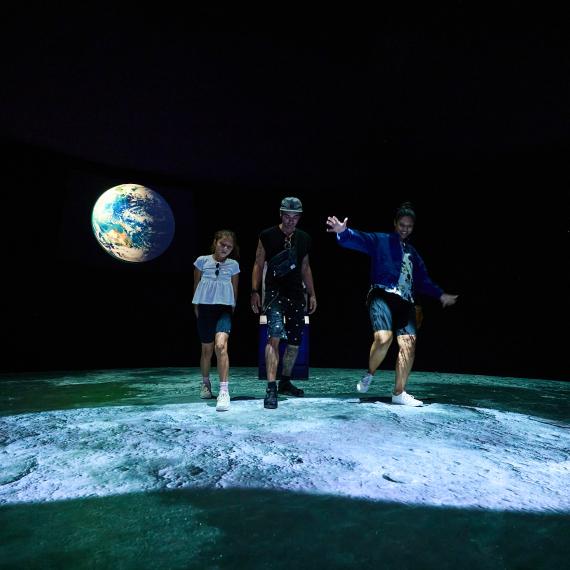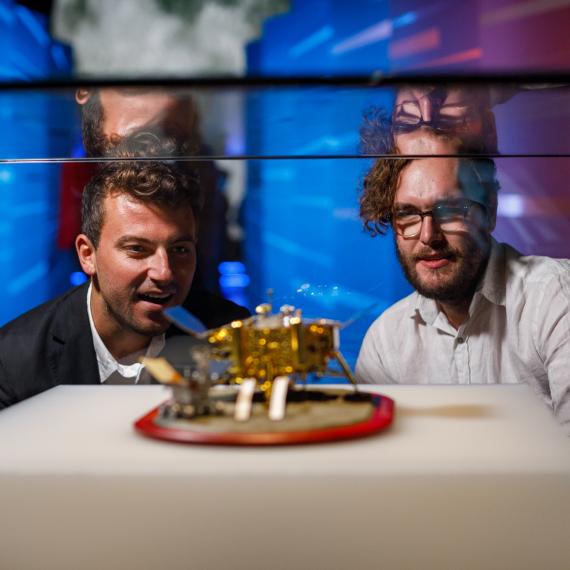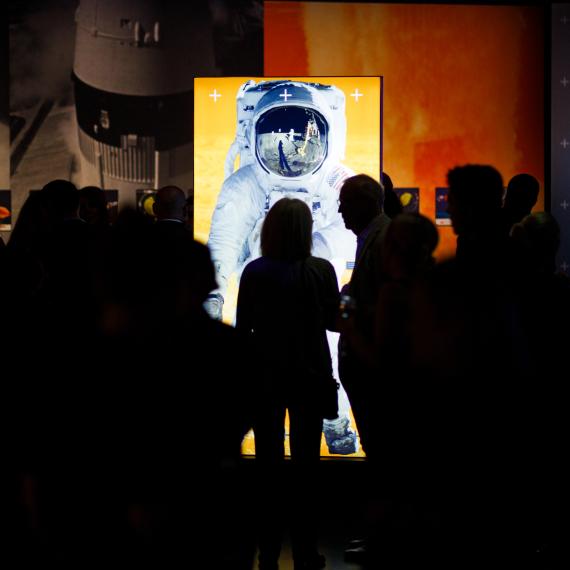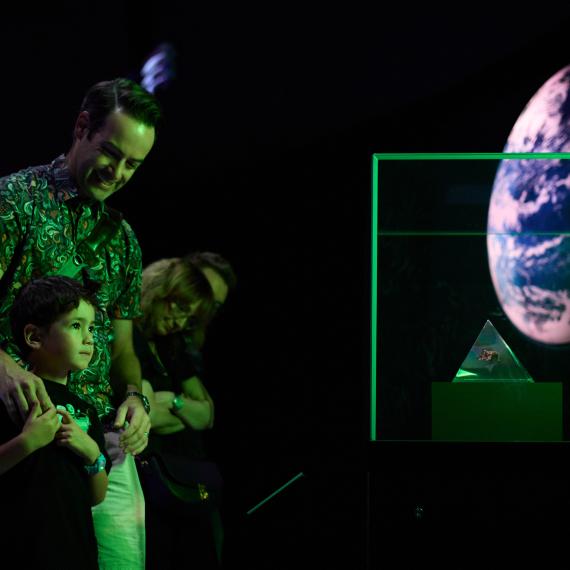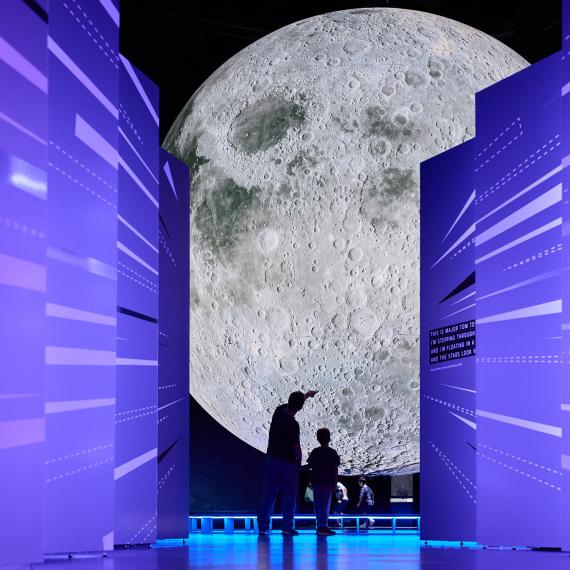The Moon is a telescope for radio astronomers with Professor Steven Tingay.
We view the Moon in visible light, but how does it appear through a radio telescope? It's a tool to study the ancient universe, detect energetic neutrinos, and gauge Earth's radio signals for potential alien detection.
Join Professor Steven Tingay to discover how the moon itself is a telescope for radio astronomers.
-
Episode transcript
[Recording] You’re listening to the Western Australian Museum Boola Bardip Talks Archive. The WA Museum Boola Bardip hosts a series of thought-provoking talks and conversations tackling big issues, questions and ideas. The Talks Archive is recorded on Whadjuk Nyoongar Boodja. The Western Australian Museum acknowledges and respects the traditional owners of their ancestral lands, waters and skies.
Facilitator: Good evening everybody and welcome to the WA Museum Boola Bardip and this Lunar Lounge exhibition. Before we begin this evening, I’d just like to take a moment to acknowledge the lands on which we are gathered on and learning here tonight, the lands of the Whadjuk people of the Nyoongar nation. May we pay our respects to elders, past and present, and extend those respects to any First Nations folks here with us tonight.
So, this evening we’re joined by Professor Steven Tingay, who over the next 40 minutes is going to be taking us through a very interesting topic: the moon as a telescope for radio astronomers. Please make the professor feel welcome.
[Audience applause]
Professor Steven Tingay: Thank you very much. Kaya, everyone. Also like to acknowledge that we are on Whadjuk Nyoongar Boodja and pay my respects to elders past, present and emerging. I’m a radio astronomer. I do a lot of work up in the Murchison region of Western Australia and the traditional owners there are the Wajarri Yamaji people, so I’d also like to extend my respect to the Wajarri Yamaji. And I do a lot of work with many people around the Yamaji nation, so to the wider Yamaji nation as well.
It’s great to be here on a Friday night. I asked the organisers how long I had to speak […] I hadn’t really paid all that much attention. And they said, ‘you know, 30, 40 minutes. Just be aware, people will have had a few drinks and so their attention span will perhaps be reduced.’ So I took that as a cue to have a few drinks as well.
[Audience laughter]
And as I […] I’ve tried to take a slightly different approach to this presentation. Radio astronomy and the moon don’t typically, you don’t think of those two things in the same sentence. But there are some really cool things about the moon that are relevant to radio astronomy and I thought it would be great to explore those. As I put the presentation together, I realised that to do that, I had to introduce quite a lot of reasonably complicated physics. So, a lot of complicated physics, 30 or 40 minutes, and a few drinks. Let’s see how we go.
So let’s get started. I’m a radio astronomer. And these are the sorts of telescopes that myself and my colleagues use to explore the universe. [shows presentation slides] So I’m not going to talk a lot about how radio telescopes work, but radio telescopes are sensitive to radio waves, radio waves like you might pick up on your car radio. Everything in the universe emits a lot of radiation, including radio waves. So we can detect radio waves using radio telescopes and understand what’s going on in the universe.
But we’re here to talk about the moon and in amongst the complicated physics, I will refer to the moon at critical but infrequent points. But here it is, as you and I know and love it. [shows presentation slides] A beautiful object in the night sky that you can see evolve over the course of a 28 day orbit. And, for me, the moon was my introduction to astronomy when I was five or six years old – had my first telescope – and the first thing you point it at is the moon, obviously. And it’s a mind-blowing experience, and I still look at the moon through a telescope and are still amazed. So it is the entry point for a lot of people into astronomy.
My real interests are a little bit further away than the moon however. I’m interested in what’s going on in our galaxy and what’s going on in the universe. So just to put that into context, here’s a few pictures. [shows presentation slides] So on the right-hand side, I guess, is a picture of the night sky that you might see similar to what you would see if you were out in a location in Western Australia away from the city. You’re looking at the Milky Way, and we know the Milky Way as this band of light that spans across the sky. The Milky Way is our galaxy composed of billions of stars and it’s the galaxy in which we live.
If we were able to take ourselves outside the galaxy and look at it from on top, you’d see something like the top left. Looking down on the galaxy, you can see it’s circular, spiral shaped structure, concentration of stars in the middle of the galaxy. If you could look at our galaxy from the edge, you’d see something like the bottom left, the galaxy side-on where you can see that it’s flat and our galaxy is a pancake structure with a spiral arm structure. That’s the galaxy in which we live. Our galaxy is composed of many, many, many billions of stars and our sun is one of those many, many billions of stars. So that’s where we live. That’s our local environment, our galaxy.
Now this is quite a different image. In the previous image, every point of light that you saw in the image was a star, an individual star like our sun. And this is quite a special image from the Hubble Space Telescope. It’s called the Hubble Deep Field. Now you can see that there are lots of points of light in this image as well. Now, the first thing I need you to do is take your…have a look at your little fingernail, hold that out at arm’s length and put it up against the sky. Cool. That’s how much of the sky this image covers.
So imagine how many little fingernails it would take to completely cover the entire sky. That’s a lot. That’s a big number. And there’s a lot of points of light in this image. There’s not a single individual star in this image. Every single point of light in this image is an individual galaxy like our own. Every single point of light in this image contains many, many billions of stars.
So take many, many billions of stars, multiply it by the number of points of light in this image, and then multiply it by how many fingernails there are across the sky. And that’s how many galaxies there are in the universe. It’s a big universe. So as a radio astronomer, my job is to explore that universe, figure out where all of those galaxies came from, what they’re doing now, and what they’re going to do into the future.
So astronomy, like any good trade, requires tools. And the first point at which the moon is useful for me tonight is to start to set the scale of the universe. So if you’re looking at the moon, light from the moon, which travels very fast but at a finite speed around about 300,000km per second, will take approximately one second to get from the moon to us. So you’re actually saying the moon as it was one second ago. So in astronomy, time equals distance because the speed of light is finite.
If you looked at the sun – now, as your mum told you, never look at the sun – the sun, the light from the sun takes about eight minutes to get from the sun to us. So you’re seeing the sun as it existed eight minutes ago. If you took our sun and placed it at a distance of 30 light years, which would still make it one of the closest stars to us, you would barely be able to see our sun. But placed at that distance, light would take 30 years to get from it to us. So you’re seeing that object as it was 30 years ago. So when we look at the most distant galaxies in the universe, we’re looking back in time millions or billions of years. We’re able to see what those galaxies were like in the far distant past.
So I’ve talked about looking at things, looking at the moon, look at the sun, look at stars. And I’ve got a picture of an eyeball here, which indicates that we’re accessing a part of the electromagnetic spectrum that we call visible light. [shows presentation slides] And that, shown there on the right-hand side, is the electromagnetic spectrum of light from low energy radio waves to high energy gamma rays. And sort of in the middle, there’s this tiny sliver of the electromagnetic spectrum of light that our eyes are sensitive to, and we call that visible light, and it has the rainbow of colours.
Astronomers are fairly greedy beasts, so we do not limit ourselves to just the part of the spectrum that we can access with our eyes. We like to have expensive toys across the entire electromagnetic spectrum. So if we want to access what’s happening in the universe at gamma rays, we need to launch satellites with gamma ray detectors into Earth orbit. So here’s a satellite called Fermi. [shows presentation slides] Very famous gamma ray telescope that’s able to examine the universe in gamma rays. And here’s a picture of the entire sky in the light of gamma rays. And we’re looking at objects in this image around about 30,000 light years away. So light takes 30,000 years to get to us.
Here’s a telescope that astronomers use to access the X-ray part of the spectrum, a telescope called Chandra. [shows presentation slides] And here’s an object that we’re looking at in X-rays and this is a nearby galaxy called Centaurus A, quite a famous galaxy. It’s formed the centrepiece of my PhD thesis actually, so quite dear to my heart. It’s about 10 million light years away, so it takes light 10 million years to get to us.
In the optical spectrum, large optical telescopes can look at galaxies millions or billions of light years away, into the early universe. And radio astronomy actually spans the entire distance scale in astronomy. But one of the really special things that radio astronomers can do is look back the very furthest into the history of the universe, all the way back virtually to the Big Bang, which was the origin of space and time, the origin of matter and energy, approximately 13.8 billion years ago. That’s the entire history of the universe.
So astronomers put together these tools, these telescopes, to look at phenomena across the electromagnetic spectrum. But that’s not all, there’s also a set of steak knives to come. There’s much more than the electromagnetic spectrum. So reasonably recently, the concept of what we call multi-messenger astronomy has arisen. So as well as the electromagnetic spectrum – messages sent to us via the electromagnetic spectrum from stars, from galaxies, from objects in the universe – there are other messengers of information that we can utilise to understand how the universe works.
So you may have heard of gravitational waves. Top left. [shows presentation slides] These are predicted by the general theory of relativity and these are ripples in the space time that are caused by extremely energetic events in the far universe. So pretty amazingly, as of a few years ago, we can now detect gravitational waves, which has opened up an entirely new window into our understanding of the universe. So we have gravitational wave detectors, using gravitational waves in addition to the electromagnetic spectrum.
There are particles, high energy particles, produced through all manner of high energy phenomena in the universe. So, bottom left. [shows presentation slides] The production of high energy particles from what we call active galactic nuclei: supermassive black holes sucking in material from a galaxy, shooting it out in jets at the speed of light, actually produce high energy particles that will then travel across the universe, to be intercepted by the Earth. So we can build particle detectors on the Earth that tell us about how distant astrophysical objects are behaving.
And bottom right. [shows presentation slides] Neutrinos. So neutrinos are a part of, an example of a particle. And I’m going to divert into neutrinos now because that’s my first path to the moon. So neutrinos are the most abundant particle that has mass in the universe. We actually don’t know what the mass of the various types of neutrinos are. We know what the total combined mass of the neutrinos is, but we don’t know individually what they are. What we do know is that neutrinos have a neutral charge. They’re not like an electron or a proton. They’re uncharged, and they also have very little mass. We do know that the masses are very, very, very small. So neutral and teeny tiny equals neutrino.
Neutrinos are produced by many different processes. Interesting thing about neutrinos is that they hardly interact with other matter. So, for example, the sun is producing untold numbers of neutrinos through the thermonuclear reactions that occur within the sun. At this particular point in time, there are likely many trillions of neutrinos passing through each and every one of your bodies without you even knowing it. They pass through most of normal matter without interacting at all.
And so understanding neutrinos and where they fit into particle physics is one of the really hottest topics in physics at the moment, and has been for quite some time. So things that produce neutrinos: well, our sun, thermonuclear reactions inside the sun. [shows presentation slides] In the middle here is a picture of a nuclear reactor and the characteristic blue light that’s produced from a nuclear reactor that you can observe through the water. So again, a nuclear reaction. And bananas also produce neutrinos, which is pretty cool. The potassium in bananas is naturally radioactive. And so, when you’re eating a banana, just be aware that you’re also ingesting neutrinos.
Because neutrinos do not easily interact with matter, in order to detect them you generally need a detector that has a lot of matter in it. This leads to some really cool experiments. [shows presentation slides] So what you’re looking at here is a detector that is approximately one kilometre by one kilometre by one kilometre cube on the seafloor of the Mediterranean Sea. It’s an experiment called KM3NeT. And what you’re seeing are suspended optical light detectors, so that when a neutrino comes in with low probability interacting with a molecule of water, it can produce a shower of particles. It can release that energy into a cascade of particles, and those particles produce what we call Cherenkov radiation. That’s actually what the blue light in the nuclear reactor is. It’s Cherenkov radiation. It’s light produced from a cascade of particles that’s produced by the initial collision of a very highly energetic neutrino or some other particle with a molecule of water, in this case. And these photo detectors exist to capture those flashes of light that are produced from those particle collisions.
So that’s pretty cool. A cubic kilometre of seawater on the floor of the Mediterranean is a neutrino detector. This is how it works in a little bit more detail, probably too much detail for people who’ve had a couple of drinks. But you have a neutrino come into a material. You have the neutrino interacting with a molecule of some description with very, very low probability, but that interaction causes a cascade of, generation of charged particles. And that cascade of charged particles, it’s actually travelling faster than the speed of light in that material. And in that process, a coherent emission of optical light is produced and that’s radiated away. So that’s the physics behind what’s going on, but the generation of the cascade is the Askaryan effect, and then the generation of the light is called Cherenkov radiation.
So finally I get to the moon, which is why you’re all here. If you want to detect neutrinos, you need a big volume of material. The moon’s a pretty big volume of material. Can we use the moon to detect neutrinos? So this is what inspired the title of the talk. The moon actually becomes part of our telescope.
So shown here are a bunch of scenarios where a neutrino strikes the moon. [shows presentation slides] In the left hand one, it interacts with some material inside the moon, and the Cherenkov radiation that’s produced just dissipates into the moon. In the middle one, a neutrino comes in and just glances the surface of the moon, interacts with some material, and the Cherenkov radiation can actually escape, escape the surface of the moon. And likewise with the one on the right. It’s a low probability scenario, but a neutrino interacting with the moon just as it’s escaping the moon, and the Cherenkov radiation escapes. So the middle scenario is the good one. The middle scenario tells you that if you consider the surface shell of material on the moon, let’s say the top ten metres, that could provide a viable mechanism to detect neutrinos.
And when you do the numbers, it’s pretty compelling. So the KM3NeT sea floor Mediterranean detector that I showed you, three, three cubic kilometres. So, you know, in the standard parlance, that’s half a million Olympic swimming pools because they’re the units we understand. But if you just take the top ten meters of material of the moon and add up its volume, it adds up to 380,000 cubic kilometres, which is 63 billion Olympic swimming pools. So that’s a big volume.
So you can design an experiment, and some of our colleagues in Australia have done this using the really famous Parkes radio telescope that you would have seen in the movie The Dish, which is a classic Australian movie. Using the Parkes radio telescope, you can design an experiment that points the telescope at different places around the limb of the moon, so shown here. [shows presentation slides] And you can also simultaneously point the telescope a bit off the moon as well, because what’s really important is that the signals that you want to detect can be mimicked by human activity. So, the radio emission from electronics that’s all pervasive can mimic the sorts of signals that you would look for from the moon. So you can put, you can look at what’s going on off the moon as a control sample.
So this is a really, really clever experiment, utilising the moon as part of your radio telescope. Now, might be a little bit difficult to see but the plot on the right-hand side shows the signal that’s expected. [shows presentation slides] And the little inset in that plot shows the signal that you might be looking for as a function of time, and it will be difficult to read, but the duration of that signal is about one nanosecond, one billionth of a second. So this is an experiment to use a radio telescope utilising the moon as a volume for neutrinos to interact with, to produce nanosecond, nanosecond bursts of radio emission that the radio telescope can then seek to detect. So super clever experiment, very, very creative. So I got there in the end. There’s the moon in amongst all the physics.
The second example I have is equally complicated unfortunately. So one of the things that we would quite like to do as radio astronomers is to understand how the first stars and galaxies in the universe formed and evolved, because that’s the initial conditions in the universe that led to us existing now. So this is a picture of the, you know, it’s a cheeky picture of the entire history of the universe in one slide. [shows presentation slides] On the left-hand side: the Big Bang, the origin of all of space, all of time, all of matter and all of energy. And on the right-hand side: 13.8 billion years later, is where we exist.
So the formation of the first stars and galaxies occurred within the first billion years of that 13.8 billion year history of the universe. So one of the really cool experiments we do as radio astronomers right here in Western Australia is look back in time 13 billion years in order to understand how those first stars and galaxies formed. This is a bit of a simulation as to what we think may have happened at that time. [shows video] The universe would’ve been filled with neutral hydrogen gas: hydrogen – one electron, one proton – masses of it. That’s one of the main things that the Big Bang produced.
Over time, that hydrogen gas collapsed into stars and galaxies. And like our sun, those stars and galaxies released energy. And that energy then propagated away from the star or galaxy and split apart the hydrogen atoms. So we call this the epoch of reionisation, when the universe went through a phase transition from neutral to ionised due to the energy produced from that first generation of stars and galaxies. So at the end of that, you’re left with a transparent universe filled with stars and galaxies.
So radio astronomers attempt to detect that phase transition. So if you have a look at, you know, where the movie is now, and then imagine that we can capture that point in time with an observation, you get images like as shown here in the left-hand three panels. So we’re looking at that phase transition 300 million years, 600 million years and a billion years after the Big Bang. And you can see that the mixture of neutral and ionised gas in the universe is changing. So that’s the signal that we would like to recover, that change in the mix of neutral and ionised gas.
That’s cool. Turns out that it’s a really, really, really weak signal. In astronomers’ units, it’s less than 50 millikelvin. Don’t ask me. Ask me later if you’re interested in what the units mean. But the point is that it’s a really, really, really small number because this is a signal in the early universe, and that signal has to reach us through the rest of the universe and the rest of the universe produces a really, really big signal. [shows presentation slides] So on the right-hand side is sort of an image of the sky, and this is an image of all the stuff between us and the signal that we’re looking for. And these foreground signals are hundreds or thousands of kelvin. So we’re looking for 50 millikelvin behind a screen of 100 or 1000 kelvin. So it’s approximately a one part in 10,000 experiment to recover this signal. It’s a classic needle in a haystack. It’s a really, really difficult experiment. It’s practically impossible. It’s right at the edge of what we can consider doing.
So I get to the moon again, which is pretty cool. So here’s that same image of the sky and I’ve got the moon on this image now. [shows presentation slides] So we know how far away the moon is, we effectively know its temperature, and therefore the moon becomes a really handy source of calibration for our radio telescopes. So what we can do is make a radio image of the sky when the moon is here. And then we can make another radio image of the same area of sky a day later or two days later, and the moon has moved somewhere else. So what you actually recover is the difference between the universe and the moon. And when you recover that difference out of your data, you can then characterise the signal from the universe, and you can start to look for that 50 millikelvin wiggle on top of a 1000 kelvin signal.
So this is actually something that people have done here in Western Australia with a telescope called the Murchison Widefield Array. Here are some actual images of the moon. [shows presentation slides] So top left is an image of the moon using our radio telescope. Now what you can see is a bright central point and a weaker, broader disk of radio emission. So that broad disc is the moon. Interestingly, the bright point in the middle is all of the radio waves that humans produce on Earth, reflected off the moon and coming back into our radio telescope. That’s pretty interesting. The top right is our theoretical model of what the moon would look like. Yep, it’s a disk. And when we model the bright spot in the middle, we get a model like the bottom left. So you can see that the two models are pretty close to reality. And if you take those models and remove them from the data, you get the bottom right.
So there’s still a little signal in the middle that’s unmodelled, but it’s actually, pretty accurate representation of the radio emission from the moon. So when you do that you can start to recover information about both the moon and the universe. So here is the spectrum of the moon. [shows presentation slides] So on the horizontal axis you’re looking at frequency, the frequency of the radio waves from about 80MHz to 230MHz. And you’re looking at the power that we’re receiving from the moon as a function of frequency. And you can see it’s pretty smooth, except for this really big bump of strong signal between about 88MHz and 108MHz. Anyone want to guess where that’s from? Does anyone know what’s between? Yeah? [audience member responds] It is FM radio. So this is FM radio from FM stations across the world broadcast out into space. Some of it hits the moon and is reflected back to the Earth, reflected off the moon. And so that is a very, very, very strong signal. So when you model that signal and remove it, you get the bottom plot, which is just the radio emission from the moon itself.
So then you can also recover information about the universe. And it’s a boring plot, but the left-hand plot shows the radio emission from the universe, also as a spectrum. So the power that we receive from the universe as a function of frequency. And you can see that it sort of has this exponentially declining curve. And so that represents the power that we’re receiving from the universe. So these data are the result of a few hours worth of observation. This shows that the technique of using the moon as a calibrator works. And if we continue to observe the moon for maybe thousands of hours, this curve would get hopefully accurate enough in order to detect those 50 millikelvin wiggles on top of the thousand kelvin background.
Just one final point, which I think is pretty cool. The right-hand panel shows, what else is reflected off the moon? So FM radio, human-produced radio waves from the Earth, going out to the moon and reflecting off. But actually, to get this result, we had to model the reflection of the radio waves from our galaxy off the moon. So the galaxy’s over here, moon’s over here, we’re over here. [indicates with hands] The radio waves from the galaxy hit the moon and are reflected off to us as well. And that’s, that turns out to be a significant signal in our data. So this is the model of what the reflection of the galaxy off the moon looks like for our telescope. [shows presentation slides]
So that’s really super cool. So this is the search, the almost impossible search for the first stars and galaxies in the universe. But when I saw this, I thought, yeah, that’s really cool, but actually, if FM radio is reflecting off the moon, what else is it reflecting off? Which triggered a little bit of a thought that we could potentially use our radio telescopes to study objects in orbit around the Earth. So we have these FM radio stations broadcasting, you know, out to the population, to your car radio, heaps of that energy escapes into space. Some of it is intercepted by objects in Earth orbit, which gets reflected back down to the Earth that we can detect with our radio telescopes. So by looking for the first stars and galaxies, we hit on a practical, real world application to detect and track and monitor the vast amount of material, human-made material, that’s in orbit around the Earth. [shows presentation slides] So that last bit is an actual movie of real images from our telescope tracking the International Space Station as it moved across the sky.
So that’s really cool that you can use fundamental science to come up with real world applications. And so this has now led to big partnerships between us and industry partners to build dedicated facilities to undertake detection and monitoring, tracking of objects in space, an activity called space domain awareness. You may have heard that quite a lot of stuff is being launched into orbit. Starlink is a constellation of satellites that will have thousands and thousands of individual satellites. Many other companies are thinking about putting mega constellations into space as well. So it’s really important that we understand where everything is, where it’s going, to be able to assess things like collision risk. So it’s a really big deal for the future. And it’s pretty amazing that some solutions can come out of astrophysics.
So this is our future in Western Australia, project called the Square Kilometre Array, the largest radio telescope ever conceived. So in Western Australia, over 100,000 individual antennas distributed over thousands of square kilometres. I haven’t got time to talk about the SKA, but it is the future of global radio astronomy. In Western Australia, we will host half of the telescope, the other half in South Africa, headquarters in the UK, in excess of a dozen countries involved in funding it, designing it, building it, operating it. So it’s an enormously big deal for Western Australia. Over the last decade, more than a decade, people like myself and many other people in Western Australia have contributed to enabling the SKA, by building and operating the radio telescopes, some of which I’ve talked about tonight.
So, top right-hand corner. [show presentation slides] The Murchison Widefield Array is one of the official precursor telescopes for the SKA. Top left, is some of the prototype antennas that we’ve worked on closely with colleagues around the world, in particular our Italian colleagues. And all of this happens out in the Murchison region of Western Australia, which is an absolutely incredible place to be. A few of us were lucky enough earlier this week to get up there and see what the progress has been.
Who’s heard about the SKA? [waits for audience response] Mmm, okay. That’s not very good. Go home and tell your friends. [audience laughter] But since the topic is the moon, it would be remiss to not talk about some of the really ambitious plans to put radio telescopes on the moon itself. Many, many concepts to do this. But here is one of them, the Lunar Crater Radio Telescope. [shows presentation slides] Astronomers are terrible with their naming of telescopes. Really, really unimaginative. We have things like the Very Large Array, and the Very Long Baseline Array. It could be a bit better.
But anyway, this is effectively a radio telescope which is designed to nestle into a crater as a naturally occurring dish shaped structure. And if you put it on the far side of the moon, the theory is that you’ll be shielded from the Earth because we never see the far side of the moon. And so any interference, any FM radio stations from the Earth, will be blocked by the moon. So if we put a telescope on the far side of the moon, we can breathe a sigh of relief. We will be immune from all of the interference caused by human beings.
Turns out, not so much. So with all of the activity to go to the moon, the Artemis missions, and many other missions, there is an entire design for a lunar communications architecture, which is a grand set of satellites and devices orbiting the moon and on the surface of the moon to provide communications from all of these missions, back to the Earth. So it turns out that humans are already there. The far side of the moon may not be, may no longer be the greatest place to do radio astronomy from.
So, I’ll leave it at that. Thank you very much for coming along. Very, very happy to take questions. As I proceeded through describing lots of other people’s work, I didn’t give credit along the way, so here is a list of credits to the organisations and individuals that produced the materials that I’ve highlighted. [shows presentation slides] So thank you very much.
[Audience applause]
Facilitator: Wonderful. Thank you very much for that. We’ve got some time for some questions, if anyone would like to ask anything. Beautiful, I’ll bring the microphone over.
ST: It’s always the guy in the front row.
[Audience laughter]
Audience question 1: I’m just wondering when the SKA is going to be fully operational.
ST: Yeah, so, construction should be complete by around about the end of the decade. Radio telescopes can be fairly tricky beasts, so there’s a bit of a history of, you know, post construction. It takes a few years to be fully operational, but the telescope will certainly generate data along the way. So sometime after 2030, I would say. But we have the SKA-Low Telescope Director with us, Doctor Sarah Pearce, and Sarah will be able to give you a much more accurate answer.
[Audience laughter]
Facilitator: Wonderful. Any further questions?
Audience question 2: Oh, so with that crater radio telescope, would you need humans there to assemble it or would it be fully robotically assembled?
ST: Yeah, the concept is that it’s fully robotically assembled.
Q2: Wow.
ST: Yeah, which is, you know, obviously an incredibly ambitious undertaking. But if you look at the state of play with robotics now, this is definitely feasible. And actually one of the great strengths of Western Australia is our ability for remote, complex operations. So there’s quite a bit of relevance that, from things that we do in Western Australia to actually working on the moon. So, probably an opportunity there for us. So if you want to build a lunar radio telescope, get on board.
[Audience laughter]
Facilitator: Time for one more question, if there’s any last ones. No? Wonderful. Well, huge thank you again to Professor Steven Tingay. Give him another round of applause.
[Audience applause]
[Recording] Thanks for listening to the Talks Archive brought to you by the Western Australian Museum Boola Bardip. To listen to other episodes, go to visit.museum.wa.gov.au/episodes/conversation where you can hear a range of talks and conversations. The Talks Archive is recorded on Whadjuk Nyoongar Boodja. The Western Australian Museum acknowledges and respects the traditional owners of their ancestral lands, waters and skies.
More Episodes
Writer, puppeteer, and folklorist Clare Testoni tells the story of the Moon's many faces in folk and fairy tales around the world.
Join Dr Natasha Hurley-Walker, ARC Future Fellow at Curtin University, as they explain how lunar radio waves let us explore the universe.
Join the stellar Sandra E Connelly and Dr Phil Bland in the To the Moon exhibition for a fascinating conversation about NASA's seven-billion-dollar mission to explore Earth, the Sun and beyond!
Join Richard Tonello as they discuss and debunk all things lunar conspiracy, from the flapping flag to flat earth theories, missing stars and the moon's reflectivity index.
Explore the realm of off-earth habitation and hear how plants can be engineered for space exploration and altered Earth climates.
A conversation between Dr Chantal Bourgault Du Coudray & Lucy Peach, discussing the cultural significance of the moon and how this relates to women.
Join Professor Eric Howell in this talk that delves into the heart of multi-messenger astronomy, highlighting its potential to decipher the intricate mechanisms driving these cosmic phenomena.
Join Dr Robin Cook on a celestial journey exploring the mesmerising interplay of the Sun, Moon, and Earth
In this talk Professor Bland outlines the mission that Curtin is developing to find ice on the Moon in accessible locations.
Join Xavier de Kestelier, Principal and Head of Design at Hassell, to hear about Hassell’s design journey and collaboration with the European Space Agency to develop a innovative concept for a thriving settlement on the lunar surface.
Join Dr Benjamin Kaebe, an engineer, researcher and teacher, as he discusses the opportunities of a Western Australian space economy.
Professor Phil Bland provided an overview of Artemis, and what the next decade of space exploration might look like.
In this lecture, Professor Katarina Miljkovic explores the impact origin of the Moon.
